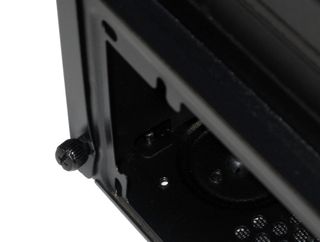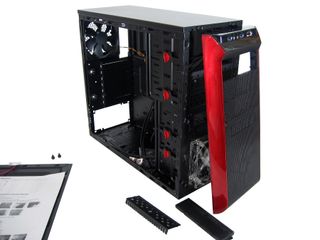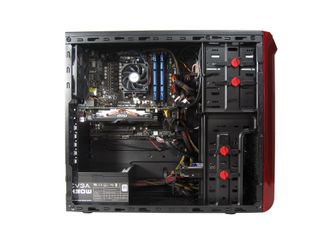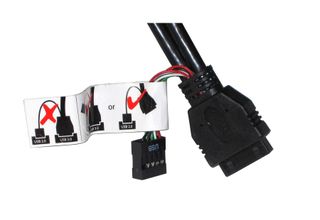System Builder Marathon, Q2 2014: Our Budget Gaming PC
Assembling Our Gaming Box

The boxes shipped from Newegg arrived in great shape, giving us little reason for concern. Closer inspection later revealed that the container with the case inside had a couple of wrinkled and rounded edges. At some point, whether during shipping or before, the box was likely dropped on its back edge, evidenced by the top and bottom right-hand thumb screws pushed in and bent to the side. When we removed them, a few loose paint chips crumbled off from the surrounding area.

Structurally, the case is still fine, and once I straightened out some of the sheet metal from the inside, this little bit of damage didn't affect motherboard or power supply mounting.

There weren't any visible scratches in the glossy red highlights along of the front edges of the enclosure, which weren't covered by protective film. However, there were some faint (but visible) scratches under the USB 3.0 and eSATA ports. Those were covered in film. So the scratches likely occurred at the factory when the ports were being installed into the bezel.
The black metal mesh was ding-free, apart from a faint hint of worn paint in a rounded area along the left edge. We probably could have masked this blemish almost completely with a black marker.

I proceeded to prep the case for use. The front bezel was held secure and never popped off on its own, but just the slightest tug from the bottom lip was enough to remove it. Next, I separated the mesh cover from the bezel, and twisted off the sheet metal from the case, exposing the top 5.25” bay for our DVD burner.
Given plenty of internal space, I didn't need to install drives or the power supply before securing our motherboard in place. This was easy enough with the CPU, heat sink, and memory already installed.

Rosewill packages the Redbone with one sheet of instructions and a bag of screws. The company includes a small speaker to attach to a motherboard header, and one bracket to cover a rear slot once the original punch-out is removed. I do have a few criticisms of the Redbone that I'd like to share, though.
Stay on the Cutting Edge
Join the experts who read Tom's Hardware for the inside track on enthusiast PC tech news — and have for over 25 years. We'll send breaking news and in-depth reviews of CPUs, GPUs, AI, maker hardware and more straight to your inbox.
The first could potentially be disheartening for novice builders to overcome, but would be easy to solve. The case supports full ATX and microATX motherboards requiring three rows of screws, just like the ASRock model we're using. However, rather than including all of the standoffs you'd require, Rosewill only bundles seven. Other customers on Newegg complain of the same oversight, so this isn't a one-time deal. Standoffs come in different heights, and these employ a low-profile design. Securing our motherboard properly required nine. So, unless we had spares on-hand, all progress would have ground to a halt. Fortunately, the extras included with Antec’s Three Hundred are the same, and I had plenty of those from prior builds.
Another easy-to-solve complaint concerns the useless drive clips. They're designed to attach on the near side, and use dimpled pressure on the rear. But this mechanism doesn't come close to holding either of our drives in place (particularly the disk drive). Thankfully, screws are also provided to secure them properly.
Next up, cable management (or, more accurately, a lack thereof). This is a roomy case, so airflow shouldn't be a problem. But there's no easy way to finish the build with a tidy appearance once the side panel is removed.

We ran into two other problems after firing up our build. First, the case fan attached to the side panel is quite noisy, and might benefit from some oil. Second, the Asus DVD burner we've used so many times before was dead on arrival (its tray wouldn't come out), and had to be returned. Newegg quickly shipped out a replacement, getting us up and running again.

In general, I've been pleased with many of Rosewill's enclosures, which is why I gave this one a shot. And despite picking on a handful of weaknesses, the Redbone remains likeable. Value is perhaps its greatest strength. The front-panel USB cable, which can adapt to fit either third- or second-gen motherboard headers, is a welcome addition. The three bundled fans are too. It was just a shame one was so noisy. But a few oversights make the case impossible to recommend enthusiastically. I feel for new builders who wind up frustrated by penny-pinching on the part of Rosewill.
Current page: Assembling Our Gaming Box
Prev Page Case, Power Supply, And Optical Drive Next Page Overclocking Our Budget AMD Platform-
LookItsRain I myself just could not see buying a setup like this because of complete lack of a CPU upgrade path.Reply -
revanchrist Please stop those nonsenses so called upgrade path. People who buy budget pc won't upgrade their pc before 2-3 years of usage at least. And by the time they are actually upgrading, they will be buying new CPU and new motherboard aka a whole new platform. But still i'll say a combination of G3258 + H97 and overclock it or a i3 4150 + H97 without overclocking will be a better option.Reply -
bemused_fred THANK YOU for finally including the cost of the OS! This is a HUGE budget consideration, ESPECIALLY for those working on low-cost builds.Reply -
Electromikey I'm personally not surprised at all that the ASUS burner was DOA. I've owned four of them, and each one has died within a month of purchase. Not a fan.Reply -
Steve Simons I'd love to see a "vote on the components" build at some point. Each decision would have 3-5 choices with your analysis of why a choice might be good or bad. Then, as readers and enthusiasts, we can vote for our choice and see what wins.Reply -
allanitomwesh Liking the new format and for once,I actually agree with the choices made on this rig!Good show there henningsen,I think it is important to consider that this month's rig,compared to last time at $750,has enough difference in price to graba monitor and keyboarg mouse combo,for a complete system,and that is a win.Reply -
Steve Simons I'm not an expert by any means, so take this with a grain of salt. Would dumping the RAM down to 4 GB have opened up the better graphics card?Reply
The reason why I ask is that budget builders, if they do choose to upgrade anything, typically upgrade RAM (due to the extreme ease at which it can be installed). This way, as they save their pennies they can make the jump from 4 GB to 8 GB while still having the better graphics card that should serve them a bit better and longer than the one in the current system. -
Traciatim I hope you stick with the budgets in the future, it seems pretty silly comparing machines from quarter to quarter with wildly fluctuation budgets. It's also nice that budget actually means entry level budget and that the cap is $1500. It seems like after that amount it just ends up throwing money at things because they sound cool rather than really changing the performance of the machine all that much.Reply
Hopefully next time we will get the see the G3258 in the budget gaming rig since even Tom's own article showed the 3258 pretty much destroying the 750k in games across the board . . . or maybe AMD could come up with something that's actually worth buying over other offerings? -
pauldh Reply13573428 said:I'm not an expert by any means, so take this with a grain of salt. Would dumping the RAM down to 4 GB have opened up the better graphics card?
The reason why I ask is that budget builders, if they do choose to upgrade anything, typically upgrade RAM (due to the extreme ease at which it can be installed). This way, as they save their pennies they can make the jump from 4 GB to 8 GB while still having the better graphics card that should serve them a bit better and longer than the one in the current system.
Actually, you are right on target. This is a big decision for budget-buyers to consider. And here is where I was most torn also. For me it somewhat comes down to current market prices. The way they rise and fall you may grab an 8GB kit later on for the price of a 4GB kit now. Though the reverse has already happened too. We bought 8GB kits for way less in the past. If budget/funding forced me under R7-260X, I'd have dropped to 4GB.
In this SBM series we run our benchmark workloads from the HDD, not RAM Drive, so it (dropping to 4GB)wouldn't show up in our benchmark charts much at all (beyond a few apps, tops). Yet jumping to R9 270 would have yielded notable gains in frame rates, and even offered higher max playable settings. Yet it also feels like a bit of a cheat on my part; a benchmark win, yet also a "daily livability" loss.
IMO computing life with 4GB isn't as productive or enjoyable. Stuttering or hitching in games, lengthened time just to exit games or switch between tasks, and even web browsing slowing to a crawl when too many tabs are open.
I got in the habit of outfitting 8GB when RAM was more affordable, especially when the entry-level mobo in use is limited to two sticks. This one supports four, so starting with 4GB becomes more practical. There's some potential for compatibility issues when adding very different memory kits. (single-sided+dual-sided) But nothing I'd worry too much about.
I'd say budget builders more than anyone should consider building in steps. That's one good reason to build rather than buy. Be it the mobo, CPU, Graphics, PSU, RAM, It's nice know part(s) of your platform has/have staying power, even if you can't afford to do it all well, right from the start.
-
pauldh Reply13572758 said:Please stop those nonsenses so called upgrade path. People who buy budget pc won't upgrade their pc before 2-3 years of usage at least. And by the time they are actually upgrading, they will be buying new CPU and new motherboard aka a whole new platform. But still i'll say a combination of G3258 + H97 and overclock it or a i3 4150 + H97 without overclocking will be a better option.
While I most certainly understand what you are saying, considering the double post directly above it, I'd also like to reiterate budget builders are the ones who should probably MOST consider the upgrade path. If you can afford to hit the upper-mainstream now across the board, fine. You may likely be happy for a few years until your next build. Or at least you'd have the platform to stay with a GPU upgrade, if desired.
But if you can't, then why settle for the disposable platform mentality and not consider advantaging upgrade potential into your plan? Remember some folks aren't keen on starting over with a fresh OS all to often. A large CPU bump while retaining the mobo, can be a huge plus for those who always feel they lack free time. Starting with a Pentium and later popping in Core i7 has huge lasting potential for those short on cash only, but not in computing desires. For my son, I even started with Celeron so he could build his own with me, and now that rig outfits i5-2500K, and the Celeron ported over to a cheap office PC. It was part of the plan all along, but the cheap chip got us up and running quicker within my budget. Best of all, it only took me minutes to upgrade.
Most Popular

